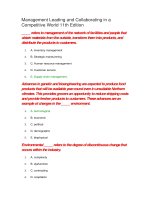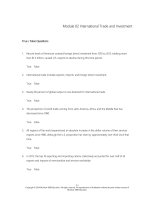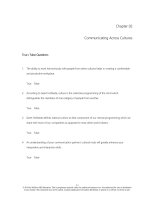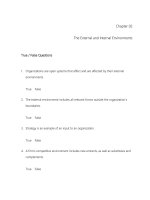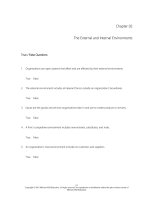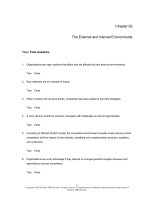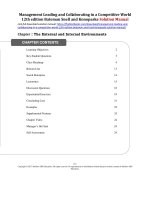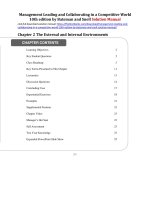Management leading and collaborating in a competitive world 12th edition bateman snell and konopaske solution manual
Bạn đang xem bản rút gọn của tài liệu. Xem và tải ngay bản đầy đủ của tài liệu tại đây (3.21 MB, 63 trang )
Management Leading and Collaborating in a Competitive World
12th edition Bateman Snell and Konopaske Solution Manual
Link full download solution manual: />
Chapter 2 The External and Internal Environments
CHAPTER CONTENTS
Learning Objectives
2
Key Student Questions
3
Class Roadmap
4
Bottom Line
13
Social Enterprise
14
Lecturettes
15
Discussion Questions
16
Experiential Exercises
19
Concluding Case
21
Examples
22
Supplemental Features
24
Chapter Video
24
Manager‘s Hot Seat
24
Self-Assessment
24
2-1
Copyright © 2017 McGraw-Hill Education. All rights reserved. No reproduction or distribution without the prior written consent of McGraw-Hill
Education.
Chapter 02 - The External and Internal Environments
LEARNING OBJECTIVES
1
Describe how environmental forces influence organizations and
how organizations can influence their environments.
2
Distinguish between the macroenvironment and the
competitive environment.
3
Explain why managers and organizations should pay attention to
economic and social developments.
4
Identify elements of the competitive environment.
5
Summarize how organizations respond to environmental uncertainty.
6
Define elements of an organization’s culture.
7
Discuss how an organization’s culture and climate affect its response to its external environment.
2-2
Copyright © 2015 McGraw-Hill Education. All rights reserved. No reproduction or distribution without the prior written consent of
McGraw-Hill Education.
Chapter 02 - The External and Internal Environments
KEY STUDENT QUESTIONS
The two questions that come up most often for this chapter are:
1. “Can you explain the difference between the macroenvironment
and the task environment?” (Or request to explain a particular
element of either environment.)
2. “As a manager, what should I do to respond to a changing environment?”
Fortunately, the text has tools to help you deal with both of these questions more effectively.
The first question is best addressed with examples, and students often find it useful to go
through an example or two for a specific company. Start by discussing the high tech industry, using the information in the text and the ―Management Connection‖ section called
―Ap-ple‘s Rocky Relationships.‖ Next, ask students to name a company with which they
are fa-miliar, and have them identify examples of each of the different environmental factors
for that organization. If your students can‘t think of an organization, try using something
with which they are likely to be familiar, such as Kaiser Permanente (a large national HMO.)
A completed example appears below in the instructions for Experiential Exercise 2.1,
―External Environment Analysis‖.
The second question is best addressed by having students work together to complete the concluding case study ―Wild Water Gets Soaked.‖ The brainstorming activity that students
complete for the third discussion question on the case also serves as an excellent
introduction to Chapter 3 - Decision Making.
―Now, create a plan for Wild Water. In your plan, describe what changes the
organization needs to make to its culture to meet the upcoming challenges in the external
environment. Then describe steps that Wild Water can take to compete successfully
against the new amusement park. How can the Salernos keep their loyal customers happy
while attracting new ones?‖
2-3
Copyright © 2017 McGraw-Hill Education. All rights reserved. No reproduction or distribution without the prior written consent of
McGraw-Hill Education.
Chapter 02 - The External and Internal Environments
CLASS ROADMAP
Management in Action
Can Mark Zuckerberg Help Facebook Reach the Next Level by
Outmaneuvering the Competition and Refocusing on Its Developers?
One of the most dramatic business stories of the past decade has been how Mark Zuckerberg created a social-networking website that helped transform how people use the Internet. Facebook,
along with other popular social-media sites, converted consumers of media content into creators
of that content, and it vastly widened the scope of what information people share about themselves.
Some observers expected that Facebook would continue to be primarily a force that changes the
online environment and social communities. However, other signs point to the possibility that
change is beginning to outpace the company. Today Facebook‘s managers are trying to keep up
with the race to mobile devices even as Facebook users are looking around for the latest hot
new thing to do online.
Introduction
LO 1: Describe how environmental forces influence organizations, and how organizations can
influence their environments
A. Organizations are open systems (Figure 2.1)
1. Receive raw materials, services, and financial, human, and information
resources from the environment, called inputs
2. Transform resources into finished goods and services
3. Send outputs back into the environment
B. External Environment Influences
1. When resources change, environment influences the organization
2. When outputs differ, organization influences the environment
3. The organization operates in a competitive environment.
E.G.
Use Example 2.1 – Environment Influences here
2-4
Copyright © 2015 McGraw-Hill Education. All rights reserved. No reproduction or distribution without the prior written consent of
McGraw-Hill Education.
Chapter 02 - The External and Internal Environments
I. THE MACROENVIRONMENT
1. Macroenvironment is defined by the most general elements in the external
environ-ment that can potentially influence strategic decisions
LO 2: Distinguish between the macroenvironment and the competitive environment
A. The Economy (Exhibit 2.3)
a. The economic environment dramatically affects companies‘ ability to function effectively and influences their strategic choices.
b. Interest and inflation rates affect the availability and cost of capital, the ability to
expand, prices, costs, and consumer demand for products.
c. Unemployment rates affect labor availability and the wages the firm must pass, as
well as product demand.
B. Technology
a. Technological advances create new products. As technology evolves, new industries, markets, and competitive niches develop.
b. New technologies provide new production techniques. Sophisticated robots perform jobs without suffering fatigue.
c. New technologies also provide new ways to manage and communicate. Computerized management information systems (MIS) make information available when
needed.
C. Laws and Regulations
1. U.S. government policies both impose strategic constraints and provide opportunities.
2. Government can affect business opportunities through tax laws, economic policies,
and international trade rulings.
3. Regulators are specific government organizations in a firm‘s environment.
4. Regulatory agencies have the power to investigate company practices and take
legal actions to ensure compliance with the laws are:
i.
ii.
iii.
iv.
v.
vi.
vii.
viii.
Securities & Exchange Commission (SEC)
Occupational Safety and Health Administration (OSHA)
Food & Drug Administration (FDA)
Federal Aviation Administration (FAA)
Equal Employment Opportunity Commission (EEOC)
National Labor Relations Board (NLRB)
Office of Federal Contract Compliance Programs (OFCCP)
Environmental Protection Agency (EPA)
2-5
Copyright © 2017 McGraw-Hill Education. All rights reserved. No reproduction or distribution without the prior written consent of McGraw-Hill
Education.
Chapter 02 - The External and Internal Environments
E.G.
Use Example 2.2 – Laws and Regulations here
D. Demographics
a. Demographics measures of various characteristics of the people
comprising groups or other social units.
b. Work groups, organizations, countries, markets, or societies can be described
sta-tistically by referring to their members‘ age, gender, family size, income,
educa-tion, occupation, and so forth.
Multiple Generations at Work
In order to address pending labor shortages over the next decade, organizations will need to find ways to
retain and fully use the talents of their experienced, older workers while competing for qualified entrylevel workers. There are many reasons why organizations will want to hire or retain seasoned
employees. Experienced employees can coach younger employees, maintain relationships with key
customers, or fill in during busy seasons. Research suggests that many of older employees are willing to
work past the tra-ditional retirement age of 65; one reason being a lack of pensions and adequate savings
will make retire-ment unaffordable for many of today‘s Baby Boomers.
LO 3: Explain why managers and organizations should attend to economic and social developments
E. Social Issues
a. Societal trends regarding how people think and behave have major implications
for management of the labor force, corporate social actions, and strategic decisions about products and markets.
b. Companies have introduced more supportive policies, including family
leave, flexible working hours, and childcare assistance.
F. Sustainability and the Natural Environment
a. Prominent issues in today‘s press pertain to natural resources.
b. The protection of the natural environment is important to managerial decisions.
II. THE COMPETITIVE ENVIRONMENT
LO 4: Identify elements of the competitive environment
2-6
Copyright © 2015 McGraw-Hill Education. All rights reserved. No reproduction or distribution without the prior written consent of McGraw-Hill
Education.
Chapter 02 - The External and Internal Environments
A. Competitors
a. As a first step in understanding their competitive environment, organizations must
identify their competitors, which may include:
i. small domestic firms
ii. overseas firms
iii. new domestic companies exploring new markets
iv. strong regional competitors
v. unusual entries, such as Internet shopping
b. The next step is to analyze how they compete.
B. New Entrants
a. Barriers to entry are conditions that prevent new companies from entering an
in-dustry.
b. Some major barriers to entry are government policy, capital requirements, brand
identification, cost disadvantages, and distribution channels.
C. Substitutes and Complements (Exhibit 2.5)
a. Technological advances and economic efficiencies are among the ways that firms
can develop substitutes for existing products.
D. Suppliers
a. Suppliers provide the resources needed for production and may come in the
form of people, raw materials, information, and financial capital.
b. Suppliers can raise their prices or provide poor quality goods and services.
c. Labor unions can go on strike or demand higher wages.
d. Workers may produce defective work.
E. Customers
a. Customers purchase the products or services the organization offers.
b. Final consumers are those who purchase products in their finished form.
c. Intermediate consumers are customers who purchase raw materials or
wholesale products before selling them to final customers.
i. Customer service means giving customers what they want or need, the
way they want it, the first time.
ii. Actions and attitudes that mean excellent customer service
include: a.) Speed of filling and delivering normal orders.
b.) Willingness to meet emergency needs. c.)
Merchandise delivered in good condition.
d.) Readiness to take back defective goods and re-supply quickly.
e.) Availability of installation and repair services and parts.
f.) Service charges (that is, whether services are ―free‖ or priced separately).
2-7
Copyright © 2017 McGraw-Hill Education. All rights reserved. No reproduction or distribution without the prior written consent of McGraw-Hill
Education.
Chapter 02 - The External and Internal Environments
Management in Action –
Progress Report
Facebook‘s seemingly dominant position among social media is under constant challenge. Increasingly,
Facebook is competing to provide services that overlap with other leading players—Amazon, Apple,
and Google. To gain an edge, Facebook relies heavily on the data it collects from its users.
• Are Amazon, Apple, and Google competitors in Facebook’s competitive environment or sellers of
com-plements? Explain.
The case describes these companies as offering some similar and some complementary services. Students
may have different opinions but should demonstrate that they understand the meaning of competing and
complementary products. For example, Google dominates search, while Facebook is launching search
tools; Amazon suggests products to buy, and Facebook suggests gifts to buy when a user congratulates a
friend; Apple sells entertainment, and using Facebook (especially to view friends‘ pictures, videos, and
so on) is a form of entertainment.
• Facebook has two major kinds of customers: the users of its site and the advertisers on its site.
What challenges does Facebook face from Google in serving each customer group?
In serving the users of its site, Facebook is challenged by Google‘s offering of an alternative social-media
site, Google+. In serving advertisers, both companies want to promise these customers the most value for
their ad spending. For example, Google might point out to advertisers that someone searching for information about cars is more likely to be shopping for cars than someone commenting about cars on Facebook; Facebook might say the conversation about cars will do more to influence a purchase decision.
Teaching Tip:
Have students review and give feedback on each others‘ responses to the pre-class assignment
(Experien-tial Exercise 2.1) at this point in the lecture. The best way to do this is in pairs. Each student
reads the other‘s paper, and then both students talk about environmental factors that have been
misclassified, and other environmental factors that could be added. Students should correct their own
papers before turning them in, and if possible, students should get feedback from the professor or
teaching assistant about both the paper and the corrections.
III. ENVIRONMENTAL ANALYSIS
LO 5: Summarize how organizations respond to environmental uncertainty
a. Developments outside the organization can have a profound impact on the way
man-agers operate.
b. Example: if little is known about customer likes and dislikes, organizations will have
a difficult time designing new products, scheduling production, or developing market
plans.
c. Environmental uncertainty means that managers do not have enough information
about the environment to understand or predict the future.
d. Uncertainty arises from two related factors:
1. Environmental complexity, or the number of issues to which a manager must attend, as well as their interconnectedness.
2. Dynamism, or the degree of discontinuous change that occurs within the industry.
2-8
Copyright © 2015 McGraw-Hill Education. All rights reserved. No reproduction or distribution without the prior written
consent of McGraw-Hill Education.
Chapter 02 - The External and Internal Environments
A. Environmental scanning
a. A process that involves searching out information that is unavailable to most people
and sorting through that information in order to interpret what is important and what
is not.
b. Competitive intelligence is the information necessary to decide how best to
manage in the competitive environment they have identified. (Exhibit 2.6)
E.G.
Use Example 2.3 – Environmental Complexity here
B. Scenario Development
a.
b.
c.
d.
Scenario is a narrative that describes a particular set of future conditions.
Best-case scenario--events occur that are favorable to the firm.
Worst-case scenario--events are all unfavorable.
Scenario development helps managers develop contingency plans for what they
might do given different outcomes.
E.G.
Use Example 2.4 – Competitive Intelligence here
C. Forecasting
a. Used to predict exactly how some variable or variables will change in the future.
b. The best advice for using forecasts might include the following:
1. Use multiple forecasts
2. Accuracy decreases the farther into the future you are trying to predict.
3. Forecasts are no better than the data used to construct them
4. Use simple forecasts
5. Important events often are surprises and represent a departure from predictions
Teaching Tip:
Ask students to imagine different scenarios that might impact your school, and to develop contingency plans
that might address those scenarios. This can either be done as a discussion question with the entire class, or
students can work in groups to answer the question, and report back. For example, a possible scenario might
center around a population boom or bust. In a population boom, universities might re-spond by setting up
satellite campuses, whereas in a bust, universities might look for additional students by setting up international
programs and/or programs targeted to meet the needs of working professionals.
2-9
Copyright © 2017 McGraw-Hill Education. All rights reserved. No reproduction or distribution without the prior written consent of McGraw-Hill
Education.
Chapter 02 - The External and Internal Environments
D. Benchmarking
a. Benchmarking is the process of comparing the organization‘s practices and technologies with those of other companies.
b. Benchmarking means identifying the best-in-class performance by a company in
a given area.
IV. RESPONDING TO THE ENVIRONMENT
A.
Changing the Environment You Are In
1. Strategic maneuvering is the organization‘s conscious efforts to change the
bounda-ries of its task environment. It can take four basic forms:
a. Domain selection is the entrance by a company into another suitable market
or industry.
b. Diversification occurs when a firm invests in different types of businesses or
products, or when it expands geographically to reduce its dependence on a
single market or technology.
c. A merger or acquisition takes place when two or more firms combine, or
one firm buys another, to form a single company.
d. Divestiture occurs when a company sells one or more businesses.
2. Prospectors are companies that continuously change the boundaries of their task environments by seeking new products and markets, diversifying and merging, or acquiring new enterprises.
3. Defenders are companies that stay within a more limited, stable product domain
E.G.
Use Example 2.5 Independent Strategies here
B.
Influencing your environment
1. Independent strategies are strategies that an organization acting on its own uses
to change some aspect of its current environment. (Exhibit 2.7)
2. Cooperative strategies are strategies used by two or more organizations working
to-gether to manage the external environment. (Exhibit 2.8)
1. Adapting to the Environment: Changing Yourself
1. Four different approaches that organizations can take in adapting to
environmental uncertainty are: (Exhibit 2.9)
a. Decentralized bureaucratic (stable, complex environment)
2-10
Copyright © 2015 McGraw-Hill Education. All rights reserved. No reproduction or distribution without the prior written consent of McGraw-Hill
Education.
Chapter 02 - The External and Internal Environments
b. Centralized bureaucratic (stable, simple environment)
c. Decentralized organic (dynamic, complex environment)
d. Centralized organic (dynamic, simple environment)
2. Adapting at the boundaries.
a. Buffering is creating supplies of excess resources in case of unpredictable needs.
b. Smoothing is leveling normal fluctuations at the boundaries of the environment.
3. Adapting at the core.
a. Flexible process allows for adaptation in the technical core to meet the varied and
changing demands of customers.
E.G.
Use Example 2.6 Corporate Culture here
C.
Choosing a Response Approach
1. Three general considerations help guide management‘s response to the environment.
a. Change appropriate elements of the environment.
b. Choose responses that focus on pertinent elements of the environment.
c. Choose responses that offer the most benefit at the lowest cost.
V. THE INTERNAL ENVIRONMENT OF
ORGANIZATIONS: CULTURE AND CLIMATE
LO 6: Define elements of an organization’s culture
A. Organization culture is the set of important assumptions about the organization and
its goals and practices that members of the company share.
1. Strong cultures
a. Everyone understands and believes in firm‘s goals, priorities, and practices.
b. An advantage if appropriate behaviors are supported.
2. Weak cultures
a. Different people hold different values
b. Confusion about corporate goals
c. Not clear what principles should guide decisions
LO 7: Discuss how an organization’s culture affects its response to its external environment
B. Diagnosing Culture
2-11
Copyright © 2017 McGraw-Hill Education. All rights reserved. No reproduction or distribution without the prior written consent of McGraw-Hill
Education.
Chapter 02 - The External and Internal Environments
1. Culture can be diagnosed through the following:
a. Corporate mission statements and official goals. (Exhibit 2.9)
b. Business practices.
c. Symbols, rites, and ceremonies.
d. The stories people tell.
2. Four types of organizational culture (Exhibit 2.10)
a. Group culture - flexible, internal focus
b. Hierarchical structure - controlling, internal focus
c. Rational culture - controlling, external focus
d. Adhocracy - flexible, external focus
C. Managing Culture
1. Espouse lofty ideals and visions for the company
2. Give constant attention to mundane, daily details
3. CEO‘s need to embody the vision of the company
D. Organizational Climate
Management in Action –
Onward
During the recent Facebook–sponsored F8 conference for developers, Mark Zuckerberg made it clear
that Facebook will be developing tools for developers to grow and make more revenue from their apps
on the social networking site. In turn, this goal will ―make users happier and marketers smarter, so
business owners will be able to more easily reach large audiences.‖
• How well do you think Facebook has been responding to its fast-changing environment? Identify risks
it is taking that could negatively impact its future growth.
Facebook is responding well to its fast-changing environment by offering concepts such as the FBStart
program and mobile applications. However, targeted ad placement may pose a risk as users may protest
at having advertisers using their information to target them for specific ads. We have already seen these
privacy concerns brought up with other organizations.
• How can Mark Zuckerberg strengthen Facebook’s culture to help the company fulfill its missions?
Methods by which managers can reinforce Facebook‘s culture include espousing a vision for Facebook that
continues the company‘s mission and values, setting an example of adhering to those values, communicating concern for those values, and rewarding employees for acting on those values. Elements of
Facebook‘s culture should be evident in the company‘s celebrations, the types of employees hired,
and the content of employee orientation and training.
2-12
Copyright © 2015 McGraw-Hill Education. All rights reserved. No reproduction or distribution without the prior written consent of McGraw-Hill
Education.
Chapter 02 - The External and Internal Environments
BOTTOM LINE
p. 47: Does low-cost mean low-quality? Why or why not?
Not necessarily. Efforts to save money can improve processes—for example, simplifying a process in a
way that reduces errors along with costs. It can involve reducing waste. It can involve locating in parts
of the world where equally skilled people accept lower rates of pay. Of course, cost cutting can also
involve using inferior material or untrained labor, so decisions about saving money should be made with
concern for the organization‘s overall strategy.
p. 47: What are some technologies that have given managers fast access to information?
Two obvious answers are the Internet and portable computers such as laptops. Students may also be familiar with other information technologies, such as wireless computing, databases, and decisionsupport systems.
p. 51: In which of these areas would you say PepsiCo tried to create a competitive advantage? (If you
aren't sure, come back to this question after you've studied this section.)
PepsiCo sought to innovate by creating snacks that are more healthful, which could also be seen as
com-peting in terms of quality. It has spent less than Coca-Cola on advertising, which is in a sense a
low-cost strategy that PepsiCo has tried to move away from.
p. 53: Would cost be a bigger barrier for someone who opens a new bicycle shop or a developer of mobile game apps? Why?
Cost would be a bigger barrier for a mobile game app, because a tremendous investment in research is
required to develop a competitive product. In contrast, once the software for a mobile app has been written, producing many copies is simple and fast, and the app can be distributed readily by offering downloads online, even if the app developer doesn‘t have much shelf space in stores.
p. 55: To meet this requirement, what qualities would a company need in its employees?
A company that can manufacture customized products quickly will need employees who are themselves
flexible—skilled in performing more than one process and willing to make adjustments to satisfy customers. The company would especially benefit from employees who are able to understand work processes
and think creatively about how to adapt them to meet customer needs efficiently.
p. 57: Name a company that has delivered good customer service to you.
Answers will vary. This is a chance for students to think about what ―service‖ means in concrete,
practi-cal terms.
p. 65: What might "flexible processes" mean for a fast-food restaurant? For an auto company?
For a fast-food restaurant, a flexible process is any part of food production that enables the restaurant to
customize its offerings, such as a selection of cheeses and condiments on sandwiches or special decorations for a children‘s party in the restaurant. For an auto company, flexible processes would likely
entail building cars with various options selected by customers, such as colors, entertainment systems,
engine sizes, and so on.
p. 71: To be aligned with its environment, what values should an organic grocery store chain
company have?
Answers will vary. Examples might be a high value placed on sustainable practices, strategies for managing waste, and monitoring of suppliers to make sure they are implementing sound farming practices.
2-13
Copyright © 2017 McGraw-Hill Education. All rights reserved. No reproduction or distribution without the prior written consent of McGraw-Hill
Education.
Chapter 02 - The External and Internal Environments
SOCIAL ENTERPRISE
Terracycle Wants to Eliminate All Waste
1. To what extent do you agree with Szaky that organizations can be profitable while
mak-ing a positive impact on the environment and society?
You can surely be profitable while making a positive impact on the environment and society. These two concepts are not mutually exclusive. For example, Terracycle converts
its waste to products that can be sold by Walmart and other large retailers. It is important to pursue a triple bottom line strategy in order to make a profit and still make a
positive impact on the environment.
2. Can you envision a world that doesn't produce waste? If so, what changes would need to
be made before that could happen?
There would need to be a lot of new procedures put into place in order to do this;
howev-er, it would be following the Terracycle approach of always converting waste to
another product – just on a much larger scale. Countries would need to invest in such a
conver-sion infrastructure. These investments would be slightly offset by the savings in
waste management, but such expenditures would be quite costly and not all nations may
follow such a “green” route.
2-14
Copyright © 2015 McGraw-Hill Education. All rights reserved. No reproduction or distribution without the prior written consent of McGraw-Hill
Education.
Chapter 02 - The External and Internal Environments
LECTURETTES
LECTURETTE 2.1
Operations and Human Resources: IBM’s Workforce Management Initiative
As the book explains, one way in which an organization can manage its competitive environment is
through becoming a globally integrated enterprise. IBM has adopted a human capital management approach to better utilize its talented workforce. Considering labor as an input and IBM products as an output, the company launched its Workforce Management Initiative (WMI) to capture and effectively leverage every employee‘s skill set and training. All of IBM‘s approximately 330,000 employees are captured
in this database. Having this database allows managers to search for employee talent within the company---around the world---rather than having to look outside to recruit talent and fill current needs. The
company estimates that this initiative has saved over $500 million. In addition to saving the company
money, applying this supply chain approach allows the company to estimate its talent capacity for future
anticipated needs as well, and to train individuals in a proactive fashion. In 2007, the IBM Institute for
Business Value published seven keys to succeed in a globally integrated world of business, written by
Eric Lesser, Tim Ringo, and Andrea Blumberg. The seven principles are:
1. Understanding the demographics and capabilities of the workforce.
2. Predicting the future labor supply and demand.
3. Utilizing social networks to increase visibility and application of knowledge across the organization.
4. Enabling individuals to perform work regardless of location.
5. Facilitating collaboration across traditional organizational boundaries.
6. Driving the rapid development of skills and capabilities to meet changing business conditions.
7. Evaluating employee performance and providing appropriate feedback.
Sources:
/>HPSKHWATMY32JVN?articleID=175002433 (accessed on December 22, 2009)
/>Teaching%20Notes_FINAL.pdf (accessed on July 29, 2015)
2-15
Copyright © 2017 McGraw-Hill Education. All rights reserved. No reproduction or distribution without the prior written consent of McGraw-Hill
Education.
Chapter 02 - The External and Internal Environments
DISCUSSION QUESTIONS
1. This chapter’s opening quote by Peter Drucker said, “The essence of a business is outside itself.” What do you think this means? Do you agree?
Students may ask: What is meant by the word ―essence?‖ It has a number of meanings. However,
according to the dictionary, it means ―that which makes something what it is.‖ It is important to
remem-ber that the purpose of a successful business is to get customers and to retain customers.
Using the definition above, Drucker‘s statement can be interpreted to mean that it is the outside environments that determine the nature of business. This can be illustrated through the use of an example. A
new automobile manufacturer entering the U.S. market is faced with three large domestic companies and
a number of well-established foreign firms. The newcomer‘s strategy has to take this external environment into consideration. This can be contrasted with a new company entering a business in which the
competition is limited to three or four small firms.
However, one can argue that even though the external environments can have a dramatic impact on a
business, it is still management‘s responsibility to develop a strategy to enable the organization to
grow and prosper.
2. What are the most important forces in the macroenvironment facing companies today?
In order to answer this question, the student probably needs to recognize that different companies operate
in different industries and a critical macroenvironment force facing one company may be a minor factor
for another. Three examples are given below:
Economy. The economy is always a factor. A booming economy may allow a new business to grow and
prosper while a depressed economy would cause it to fail. Some businesses do very well in booming
economies whereas others (notably the entertainment industry) seem to flourish during times when the
economy is weak.
Technology. Consider the impact of rapidly changing technology on the computer industry. Most of the
early innovators are no longer in business, and many of the current leaders might not survive another
dramatic change in technology. And yet, in other industries (such as candy making), the technology has
been unchanged for many years.
Political/legal. This factor is having a major impact on the television/telephone/computer interface. Political efforts to increase competition in the cable television industry will probably be a major factor for
many years to come.
Students should be able to identify industries in which each of the forces in the macroenvironment is
playing a major role or, at least, have done so in the past.
3. What are the main differences between the macroenvironment and the competitive
environ-ment?
The macroenvironment consists of the major forces (international, economic, social and natural,
demographic, technological, and political/legal) which affect all businesses to some degree.
2-16
Copyright © 2015 McGraw-Hill Education. All rights reserved. No reproduction or distribution without the prior written consent of McGraw-Hill
Education.
Chapter 02 - The External and Internal Environments
While the competitive environment is also part of the external environment, it is viewed separately from the macroenvironment in that it focuses on the competitive forces that are specific to
each business.
4. What kinds of changes do companies make in response to environmental uncertainty?
Organizations may adapt to the environment by altering their work structures and work processes in
order to reduce uncertainty. When uncertainty arises due to environmental complexity, many
organizations adopt more decentralized decision-making structures. This allows people with the most
direct knowledge of a particular product or operation to make important decisions rather than a
centralized unit that may be more removed from the daily business activities.
When uncertainty arises due to changes in the environment, many organizations adopt more
flex-ible structures. When technologies, customers, and competitors change rapidly, a highly
rigid, bureaucratized organization is less able to respond effectively, thus responsiveness and
innova-tion become priorities
Organizations can adapt to uncertainty by buffering at both the input and output sides of their
boundaries. They may do this by hiring temporary workers during rush periods on the input side,
and by maintaining adequate inventory in order to manage a rush of orders on the output side.
Organizations may also adapt at their core by establishing flexible processes such as mass customization which allows an organization to produce large quantities at low cost, yet still offer individual customization.
5.
We outlined several proactive responses organization can make to the environment. What
examples have you seen recently of an organization responding effectively to its
environment? Did the effectiveness of the response depend upon whether the organization
was facing a threat or an opportunity?
A number of proactive responses to the environment are identified in the text:
Independent strategies: The firm acts on its own to change some aspect of the current environment through competitive aggression, competitive pacification, public relations, voluntary
action, legal action, or political action.
Cooperative strategies: The firm collaborates with another organization to either reduce their
costs and risks or increase their power relative to the environment.
Strategic maneuvering: The firm attempts to change the boundaries of its competitive environment through domain selection (entering new markets with limited competition or regulation), diversification (investing in different types of business), mergers and acquisitions, or divestiture.
Challenge students to identify firms that are adopting each of these strategies and whether or
not they are doing so in response to a threat or an opportunity.
6.
Select two organizations that you are interested in. Research information about the firms or
talk with an employee if possible. What types of cultures do they have? Write a paragraph
that describes each culture.
EXAMPLE: ―Company X seems to really care about their new employees. The employee I
spoke to told me that the company actively encourages employees to move from job to job within
2-17
Copyright © 2017 McGraw-Hill Education. All rights reserved. No reproduction or distribution without the prior written consent of McGraw-Hill
Education.
Chapter 02 - The External and Internal Environments
the organization - that sounded great to me. In addition, I found out that people have a lot of flexibility to work on their terms - for example, being in the office at 9am doesn‘t matter as much as
whether or not you get the job done. To me, this company looks like it has a group culture.‖
7.
When you were visiting colleges to decide where to attend, were there cultural differences
in the campuses that made a difference in your choice? How did these differences impact
your decision on which college to attend?
Student responses to this question will differ widely, but if they understand the concept of
culture, they should talk about the ―feeling‖ a place has - organized, productive, friendly, etc. If
students have visited several college campuses, they should definitely be able to talk about
difference in culture for each campus. For example, in California, one might have perceive USC
as being very sports-oriented, Occidental as being very arts-oriented and exclusive, UCSD as a
school that pro-duced ―renaissance people‖, CalTech as being a place for brains and geeks, and
San Diego State as a party school. Note that all of these perceptions of culture have value
judgments attached to them, and they may or may not be accurate.
2-18
Copyright © 2015 McGraw-Hill Education. All rights reserved. No reproduction or distribution without the prior written consent of McGraw-Hill
Education.
Chapter 02 - The External and Internal Environments
EXPERIENTIAL EXERCISES
EXERCISE 2.1: EXTERNAL ENVIRONMENT ANALYSIS
Objective: To give students the experience of performing an analysis of a company‘s external environment.
Responses to the external environment questions will vary depending on the companies and
indus-tries the students discuss.
Suggested Responses to Discussion Questions
1. What has the company done to adapt to its environment?
Using the music industry as an example, explain how in order adapt to the environment, music companies are taking over more of the supply chain, manufacturing their own CDs and managing their
own music clubs. They are making deals with on-line music distributors to sell individual songs.
They are also increasing their on-line marketing efforts, as in letting AOL offer its customers music
video and song samples.
2. How does the company attempt to influence its environment?
Continuing with the music industry example, students might indicate that in order to influence the environment, music companies pay slotting fees to retailers to gain shelf space, and pay fees to ensure
play time on radio stations. They heavily market new releases. They are aggressively seeking to enforce copyright laws forbidding illegal copying - their success in shutting down Napster is an example
of that. They are also enlisting the artists themselves in an effort to educate and influence the public
on the illegal copying issue. In the U.S., they are also asking the government to pressure China to reduce the widespread music piracy in that country.
EXERCISE 2.2 - CORPORATE CULTURE PREFERENCE SCALE
Objectives
To expose students to different types of corporate cultures.
To help students identify the kind of organization in which they would most
like to work.
To help students see how classroom cultures can differ along the same lines
as corporate cultures.
Case Discussion Questions:
1. Review the four types of corporate cultures outlined in the exercise. Working in small
groups, give examples of classes you have taken that correspond to each of the
different types of corporate culture dimensions.
Student responses will vary, but in general, you can expect to see the following
differences across different types of classrooms:
2-19
Copyright © 2017 McGraw-Hill Education. All rights reserved. No reproduction or distribution without the prior written consent of McGraw-Hill
Education.
Chapter 02 - The External and Internal Environments
Control Culture - These classes have professors that are firmly in charge of the class and
they let students know it. Typically, professors in a control culture will take roll, have large
amounts of homework (which may or may not be meaningful to the students), and will give
difficult tests that may or may not be related to the work done previously in class. Control
culture classes often place a lot of emphasis on memorization as a learning tool.
Performance Culture - These classes have professors that are interested in learning and
who foster a learning environment with their students. Class assignments are typically
relevant and give students new skills, and although tests may be difficult, they are clearly
related to what has been presented in class. Students often describe these classes as
challenging, but fair and interesting. In a performance culture, the primary emphasis is on
learning and growth.
Relationship Culture - These classes have professors that become ‗friends‘ with students.
Students feel that their opinions count, that their voices are heard, and that they contribute
to learning, along with the professor.
Responsive Culture - This class is constantly changing to keep up with the latest changes in
the field. It may be taught online or it may evolve as students bring in additional information.
2. How do you know what kind of culture a class has? What do you look for that tells you
how the class is going to be?
Again, student responses will vary, but students are likely to talk about professor behavior
(business practices), the class syllabus (corporate mission statement and official goals),
ritual-ized behaviors such as distributing paperwork and taking roll (symbol, rites, and
ceremonies), and student reviews of the class (the stories people tell.)
2-20
Copyright © 2015 McGraw-Hill Education. All rights reserved. No reproduction or distribution without the prior written consent of McGraw-Hill
Education.
Chapter 02 - The External and Internal Environments
CONCLUDING CASE
Tata Motors: From Cheap to Awesome?
Case Summary:
This case reveals how important it is to organizations of all sizes to be prepared and ready to
change both marketing and manufacturing strategies. When Tata introduced the Nano, it stated
that the car would be sold for $2,000 to $2,500, but it was later found out that this price could
not be sustained. Moreover, there were numerous safety issues with the car. This led to a change
in the features of the Nano, and the entire pricing model, in order to stay competitive with
competi-tors such as Suzuki.
Chapter Topics Related to the Case:
Discuss how environmental forces impact organizations
Describe the purpose of an environmental analysis
Discuss how organizations like the Tata operation can conduct environmental analyses
Discuss how organizations such as Tata change culture
Case Discussion Questions:
1. Which barriers to entry contributed most to Tata Motors lack of success with the
original Nano?
Tata Motors suffered from a cost analysis mistake in the way it priced its model. It was not able to
enter the market in a competitive fashion against Suzuki. There was also an issue with the brand as
there were numerous safety issues reported.
2. Which macroenvironment factors did Tata Motors consider when adjusting the
marketing and manufacturing strategies to achieve success with the more recent Twist
and LX models?
Tato focused on technology and demographics in revamping the Nano. It focused on young urban
customers instead of first time rural buyers. There were also technological upgrades such as power steering, Bluetooth connectivity and other enhanced interior and exterior features.
3. To what degree of you believe Tata Motors will succeed in delivering a successful
low cost vehicle to consumers in India and other developing economies?
The new focus on a different set of demographics, as well as technological advances, puts Tata
Motors in good shape for competing with companies like Suzuki. The car is a bit more expensive,
but the market focus is a bit different, and there are some advancements that may justify the
higher price. The buying power of this demographic is a bit more, and the technological
advancements are what this set of demographics also demands.
2-21
Copyright © 2017 McGraw-Hill Education. All rights reserved. No reproduction or distribution without the prior written consent of McGraw-Hill
Education.
Chapter 02 - The External and Internal Environments
EXAMPLES
Example 2.1 – Environment Influences: In August of 2013, Jeff Bezos, Amazon founder and
CEO, purchased the Washington Post. The newspaper industry has been suffering over the past
decade due to customers increasingly relying on the Internet for news coverage. The Post‘s newspaper division‘s revenue declined by 44% in the preceding six years. Some are optimistic, while
others remain skeptical about Bezos‘ ability to turn the newspaper or its industry around. Bezos
stated, ―I don‘t want to imply that I have a worked out plan. This will be unchartered terrain,
1
and it will require experimentation.‖
Example 2.2 – Laws and Regulations: The macroenvironment is composed of international, legal and political, economic, technological and social forces that influence strategic decisions.
Many of these factors affect a manager‘s ability to function effectively and influence their strategic choices – interest and inflation rates, unemployment rates, rising energy costs, rising health
care costs and changes in the value of the dollar to name a few. In Malaysia when the cost of doing business is artificially inflated, the customer bears the charge without any real gain in value.
One such example was The Private Healthcare Facilities and Services Act (1998) and Regulations
(2006). This act stipulate higher charges by private medical practitioners to which must be added
2
the cost of registration.
Example 2.3 – Environmental Complexity: Recently, more and more Americans are becoming
aware of the environment - specifically the air that they breathe. With concerns about global
warming and pollution at an all-time high, people want to be sure that they and their companies
are acting in environmentally responsible ways. Americans spend 90% of their time indoors and
much of that at work. According to the EPA, air pollution is up to five times worse inside than
outside. Harsh cleaning chemicals contribute to the problem. Approximately 37 million Americans suffer from chemical sensitivity, leading to increased absenteeism and health costs. Managers who promote the use of eco-cleaners, which do not evaporate harmful materials into the air,
can reduce their costs, make the workplace safer for their workers, and improve their reputation
3
as part of the ―green movement‖.
Example 2.4 – Competitive Intelligence: Faced with declining customer-service ratings and
prices higher than competitors, Michael Dell recently resumed the role of chief executive at the
company he founded. His initial steps to be more competitive focused on eliminating redundancies throughout the business. He began by eliminating eight senior executives, suspending bonuses and providing limited discretionary awards to exceptional performers. Dell urged employees to work quickly to turnaround the company. He said ―There is no luxury of time. The com4
petitors are fierce.‖
Example 2.5 – Independent Strategies: As global warming is threatening the viability of Aspen‘s famed ski resort, companies there are responding by becoming pioneers in corporate environmentalism. Aspen uses biodiesel fuel in its bulldozer-sized snowcats, uses a speck of dust to
seed artificial snowflake which consumes less water and energy, vehicle shop is partly heated
with used motor oil, Coke machines run on motion sensors, toilets have two different flush settings—half flush and full flush, and resorts add $2 a day to the bill of every hotel guest donating
1 Farhi, Paul. “Washington Post to be sold to Jeff Bezos, the founder of Amazon.” The Washington Post, August 5, 2013.
Retrieved from />2
Singh, Beldev. “Keep cost of doing business low.” New Straits Times (Malaysia). August 21, 2006, pg. 25.
3
4
Boulden, Jennifer. “The air in there.” Fast Company, September 2007, Iss. 118, pg. 64.
Techweb Newswire. “Dell suspends bonuses, streamlines management.” February 5, 2007
2-22
Copyright © 2015 McGraw-Hill Education. All rights reserved. No reproduction or distribution without the prior written consent of McGraw-Hill
Education.
Chapter 02 - The External and Internal Environments
it to the Aspen Valley Land Trust to preserve open space. Aspen managers must complete an environmental impact assessment for each request for capital spending. Auden Schendler, Aspen‘s
director of environmental affairs, wants ―Aspen to be a thought leader – not just to be doing it,
5
but talking about how we do it.‖
This is a good example of both the public relations and voluntary action approaches to
changing the environment. (Table 2.4)
Example 2.6 – Corporate Culture: Tony Hsieh, CEO of shoe retailer, Zappos, is passionate
about corporate culture, ―The original idea was to add a little fun.‖ Now companies around the
world are attempting to model Zappos‘ renowned corporate culture and customer service
model. Zappos employees are given the freedom to decide how best to satisfy their cutomers,
whether that means staying on phone calls for hours at a time, sending flowers, or even
redirecting a cus-tomer to a rival website with a better price. Hsieh observes, ―They may only
6
call once in their life, but that is our chance to wow them.‖
5
Fishman, Charles. “Degree of difficulty.” Fast Company, February 2007, Issue 112, pg. 94
6 Palmeri, Christopher. “Zappos retails its culture.” Bloomberg Businessweek. December 2009. Retrieved
from />
2-23
Copyright © 2017 McGraw-Hill Education. All rights reserved. No reproduction or distribution without the prior written consent of McGraw-Hill
Education.
Chapter 02 - The External and Internal Environments
SUPPLEMENTAL FEATURES
Please see the following additional materials in Connect.
CHAPTER VIDEO
Opportunity International
For over 25 years, Opportunity International has provided microloans to help impoverished people in
underdeveloped nations improve their lives and work their way out of poverty. Opportunity International recognizes that poverty is multidimensional, and relies on principles of microeconomics to foster economic development. As just one example, Opportunity International was involved in helping an
individual begin a small mushroom farming and production business that began as a way to feed one
family but expands to affect over 100 local individuals trained as the business grows and becomes
more sustainable. Opportunity International is effective at growing a free market economy. The key to
successful economies is freedom and the result is the opportunity for all to have a better life. Opportunity International is in the midst of an effort to expand in Africa and benefit 100 million working
families on that continent.
MANAGER’S HOT SEAT (MHS)
There are no Manager‘s Hot Seat clips for this chapter
SELF-ASSESSMENT
Corporate Culture Preference Scale
2-24
Copyright © 2015 McGraw-Hill Education. All rights reserved. No reproduction or distribution without the prior written consent of
McGraw-Hill Education.
The External
and Internal
Environments
Chapter Two
Copyright © 2017 McGraw-Hill Education. All rights reserved. No reproduction or distribution without the prior written consent of McGraw-Hill Education
